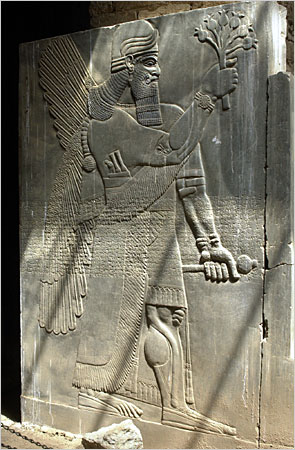Nimrud
|
|
If this is not what you were looking for, please see Nimrod or NiMUD.
Nimrud is a ancient Assyrian city located south of Nineveh on the river Tigris. The ancient city covered an area of around 16 square miles. Ruins of the city are found in modern day Iraq, some 30 km southeast of Mosul. The Arabs called the city Nimrud after Nimrod, a legendary Assyrian hunting hero, the father of the Assyrian founder Ashur (Assur).
Assyria_-_Portal_Guardian_from_Nimroud._British_Museum_04982r.jpg
Nimrud has been identified as the site of the biblical city of Calah or Kalakh [kä'läkh]. It was founded by Assyrian king Shalmaneser I in the 13th century BC and gained fame when king Ashurnasirpal II of Assyria (c. 880 BC) made it his capital. He built a large palace and temples on the site of an earlier city that had long fallen into ruins. A grand opening ceremony with festivities and an opulent banquet in 879 BC is described in an inscribed stele discovered during archeological excavations. The city of king Ashurnasirpal II housed perhaps as many as 100,000 inhabitants, and contained botanic gardens and a zoologic garden. His son, Shalmaneser III (858-824 BC), built the monument known as the Great Ziggurat, and an associated temple. The palace, restored as a site museum, is one of only two preserved Assyrian palaces in the world, the other being Sennacherib's palace at Nineveh.
Calah remained the Assyrian capital until around 710 BC when first Khorsabad and then Nineveh were designated as the capital. It remained a major centre and a royal residence until the city was completely destroyed in 612 BC when Assyria succumbed under the invasion of the Medes and the Babylonians.
Archaeology
The ancient sites at Nimrud were first investigated from 1845 to 1851 by Austen Henry Layard, who at first mis-identified the site as the city of Nineveh. His book Nineveh And Its Remains [Abridged and Titled Discoveries at Nineveh] refers in fact to this site. Subsequent major excavations were headed by Max Mallowan (1949 - 1957) and David Oates (1958 - 1962).
Excavations revealed remarkable bas-reliefs, ivories, and sculptures. A statue of Ashurnasirpal II was found in an excellent state of preservation, as were colossal winged man-headed lions guarding the palace entrance. The large number of inscriptions dealing with king Ashurnasirpal II, provide more details about him and his reign than are known for any other ruler of this epoch. Portions of the site have been also been identified as temples to Nunurta and Enlil, a building assigned to Nabu, the god of writing and the arts, and as extensive fortifications.
The palaces of Ashurnasirpal II, Shalmaneser III, and Tiglath-pilesar III have been located. The famous black obelisk of Shalmaneser III was discovered by Layard in 1846. The monument stands six and a half feet tall and commemorates the king's victorious campaigns of 859-824 B.C. It is shaped like a temple tower at the top, ending in three steps. On one panel, Israelites led by King Jehu of Israel pay tribute and bow in the dust before king Shalmaneser III, who is making a libation to his god. The cuneiform text on the obelisk reads "Jehu the son of Omri", and mentions gifts of gold, silver, lead and spear shafts.
The "Treasure of Nimrud" unearthed in these excavations is a spectacular collection of 613 pieces of gold jewellery and precious stones. It has survived the confusions and looting after the invasion of Iraq in 2003 in a bank vault, where it had been put away for 12 years and was "rediscovered" on June 5, 2003.
External links
- Nimrud/Calah (http://ancientneareast.tripod.com/Nimrud_Calah.html)
- Images (http://oi.uchicago.edu/OI/IS/SANDERS/PHOTOS/MESO/NIMRUD/nimrud1_1.html)
- More images (http://news.nationalgeographic.com/news/2003/05/photogalleries/iraqtreasures_1/) from the National Geographic.
- Treasure of Nimrud rediscovered (http://www.ancientsites.com/aw/Post/150788) — Article from the Wall Street Journal posted to a message board.de:Nimrud

